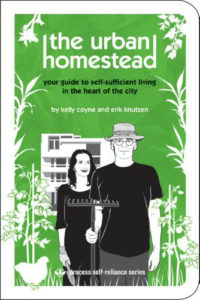The Urban Homestead, by Kelly Coyne and Erik Knutzen. Port Townsend, Washington: Process Media, 2008.

The book begins with the enticement of mouth-watering vegetables that deliver more flavor, more vitamins, and more moral high ground than the commercial variety found in your local grocery store. A myriad of typos aside, the reader is drawn into the promise of a paradigm shift by means of simple, baby steps. Starting your own farm begins with a window garden and gently moves toward the idea of edible landscaping. But quickly the concepts of permaculture and guerrilla gardening are introduced, giving the reader the sense of being indoctrinated into the world of the intrepid survivalist.
Chapter two, “Essential Projects,” seduces the reader into some modest endeavors to start the journey of transformation. The authors are clearly experienced and give helpful advice, providing guidelines for both the tentative as well as the intrepid explorer. A helpful, topic-oriented reference section is included at the end of the book.
The tone of the book is well informed and good-humored, but not dogmatic. Although the research goes beyond the experience of the authors themselves, we are reminded that this is merely a survey. Nonetheless, we are soon faced with subjects that are not for the faint at heart, including dumpster diving and raising pigeons for food. However, the reader is not left feeling inadequate if the lure of these activities fails to attract. The reader is now informed and can move onto the next section without judgment.
The chapter on Revolutionary Home Economics is neither revolutionary nor sexy. Rather, urban homesteaders are offered pragmatic examples of what to do with the fruits (literally) of their labor. Topics as mundane as making jam are examined. Fortunately, phrases such as “preservation is transformation” provide a sense of purpose, if not a chuckle. Non-toxic cleaning is also addressed with a none-too-subtle but amusing disdain for commercial cleaners. The section is wrapped up with an overview of locating and sizing one’s homestead.
The penultimate chapter tackles water and energy use. Here, a number of strategies are introduced, but openness to differing points of view is acknowledged as the authors air their own disagreement on clothes drying. Though one of the longer chapters, details are short, as the complexities of graywater harvesting are complex. Nevertheless, the author’s philosophy of keeping it simple and being “neither luddite nor geek” serves the reader well, as technical and innovative topics from solar power to passive cooling are adeptly summarized.
The book concludes with a brief chapter on transportation, encouraging the use of biking, walking, and public means. Throughout the book, we are given little snippets from folks who have adopted one urban homesteading practice or another. Much of them appear flat against the energy the authors are able to convey. A notable exception is the final endorsement of bike riding by singer David Byrne, of the Talking Heads, from his on-line journal.
This book is an earnest attempt to entice and educate readers on a journey of transformation. The topic is timely, with green trends in the media and a resurgence of urban gardening from a younger generation. The zeal of the authors is tempered by the understanding that any step in the right direction is a good step and an acknowledgement that extremists won’t provide the encouragement needed for a mass movement. Coyne and Knutzen show sincere concern for the planet and all its people with a deft roadmap that pays tribute to our need to be respected, as well as entertained.
Reviewer David Scott Bruce is Vice President of InnerSpace Engineering and a LEED AP working toward a green MBA from the Presidio School of Management in San Francisco, where he combines his mind for business and his love of nature.
Originally published 3rd quarter 2009, in arcCA 09.3, “Beyond LEED.”





